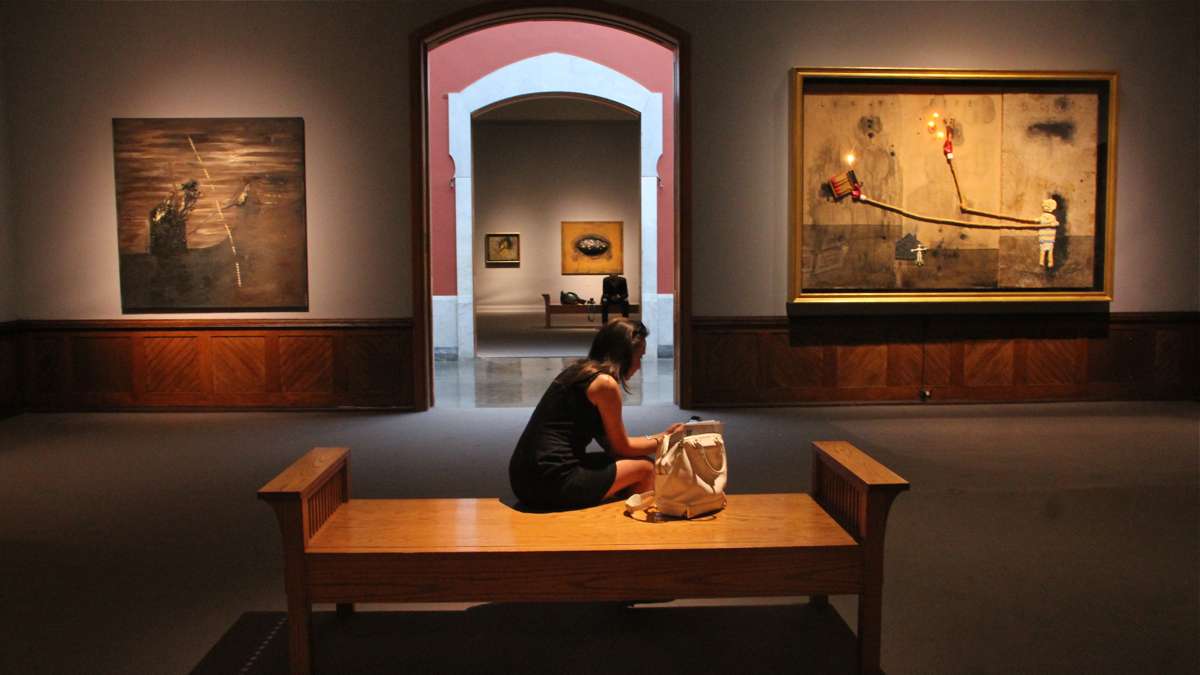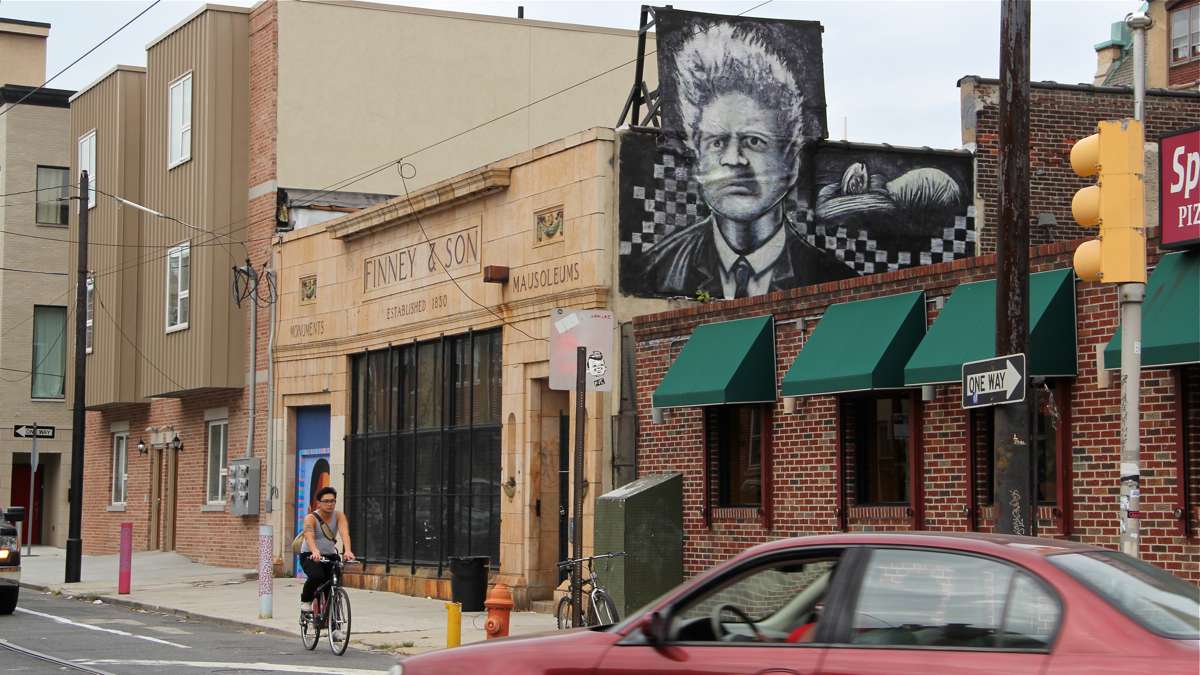PAFA celebrates alum David Lynch with ‘Unified Field’
ListenDavid Lynch grew up in Montana and came to Philadelphia in 1966 to study advanced painting at the Pennsylvania Academy of the Fine Arts. What he found was a big eastern city in decline.
“Every building was black, soot-covered,” said Lynch on a recent return to the city of his alma mater. “It was before graffiti. It was very pure, very filthy, but had a beautiful mood.”
The year and a half he spent at the Pennsylvania Academy of the Fine Arts, and four more years living and working in Philadelphia — where he married the first of four wives and had the first of four children — colored his work for the next four decades.
“The proportions of the rooms in Philadelphia were different than I had seen before,” said Lynch. “There was dark carved wood, banisters and stairways, and there was a certain type of green. The rooms were painted white or a strange green, with dark wood. It had a unique look, and a purity. It hadn’t been disturbed — except by soot.”
Lynch lived in a few places in the city, including an apartment at 13th and Wood he shared with Jack Fisk, who would become an art director for films. Lynch befriended the night watchman at the city morgue across the street, who let him come in at night (Lynch kept nocturnal hours) to visit the corpses.
Later, Lynch married fellow PAFA student Peggy Reavey and bought a house at Poplar and Girard. Soon afterward, a 13-year-old boy was shot to death a few yards away from their home.
Absorbing and expressing Philadelphia
After he left Philadelphia for film school in Los Angeles, Lynch said it took a year to shake the fear that he had collected in Philadelphia. During that time he started making his first feature film, “Eraserhead,” a dark, claustrophobic vision of urban life.
Being short on money, Lynch lived in the sets he built for “Eraserhead,” an imagined dreamscape of horror and paranoia based on his feelings of Philadelphia. The neighborhood around 13th and Wood streets is now affectionately called “Eraserhood.”
And he never stopped painting.
Many of the works in the new show at PAFA — “The Unified Field” is on view until January — are mini-narratives, frozen in an awkward moment. Some of his later works include text in the image, with words like “This day the dog went and did bite a chicken” and “I am running home from your house.”
“I like to think of a little story in a world a few frames before the world you see, and a few frames after,” said Lynch.
When he came to PAFA, Lynch had no interest in making films. He wanted to paint. But a hallucinogenic moment while working on a canvas convinced him to make pictures that moved, and made sound.
In one of the galleries of “Unified Field,” a TV monitor shows some of Lynch’s first experiments with film, including “Grandmother,” the film that won him a scholarship to the American Film Institute.
It also has a whimsical little film of people at party, cut to some jaunty music.
“This is a film David Lynch made in 1967 at the opening of the artist James Havard’s exhibition, ‘Crayola,’ that happened at the Dianne Vanderlip gallery, which no longer exists,” said PAFA curator Bob Cozzolino. “What’s great about it is that this is David shooting the Philadelphia art scene, and shooting his friend’s opening.”
‘Something in the air that was very good’
While Lynch was absorbing the Philadelphia art scene, he was also taking inspiration from his peers.
“There was a whole group of extremely talented people here. It was pretty intense,” said Bruce Samuelson, a fellow student with Lynch and now on the faculty of PAFA. “It’s pretty intense now, but back then it seemed more concentrated, maybe because of the turmoil in the city, and the war.”
North Philadelphia had just experienced a devastating riot, and Police Commissioner Frank Rizzo was establishing a heavy-handed force that would crack down on the African-American community and the counterculture.
“It wasn’t all bleak. The students were inspiring. It was beautiful,” said Lynch. “There were also scientists that were our friends. The semiconductor ferroelectric I remember hearing about at parties. It was a great group. C.K. Williams, a great poet, was a friend. There was something in the air that was very good.”
“There was excitement in the city, that I haven’t seen in many years,” said Rodger LaPelle, an artist and owner of the Rodger LaPelle Gallery on Second Street.
LaPelle was at the Institution of Contemporary Art in 1962 when Andy Warhol had his first museum exhibition. He was at the Gershman Y when Allan Kaprow staged a “happening” in 1965.
And he discovered Lynch in 1968 when the art student showed his first film, “Six Men Getting Sick,” a one-minute animation loop projected onto a resin screen Lynch had sculpted with disembodied heads in the act of vomiting.
“That’s the first time I ever saw that,” said LaPelle, remembering his first meeting with Lynch. “I said, ‘What are you up to?’ He said, ‘I’m broke, my girlfriend is pregnant, I don’t have a job, and I’m out of art school.’ I said, ‘Well, you look like you could be a comer.'”
LaPelle hired Lynch to do some printing work, and paid him $25 for any painting he would produce. Lynch, to this day, is grateful.
“Rodger LaPelle and [his wife] Christine McGinnis were saints to me,” said Lynch. “They hired me to print at their place. They saved my life. Rodger paid me to paint.”
Recently, Lynch has been able to return to Philadelphia a couple times and revisit his old stomping ground. The old industrial factories are still there, but now they are compartmentalized with new startups and cooperative workspaces. Old City is filled with art galleries and boutiques. It’s no longer the Philadelphia of his nightmares.
“Philadelphia is much brighter than when I was here. It doesn’t feel cut off from the world,” said Lynch with a tone of disappointment. “It used to be that Philadelphia was listening to a certain music and dressing in a certain way, and Brooklyn had a certain music and was dressing in a certain way, and Los Angeles. Now everything is more uniform. It’s joined the rest of the world. It’s more normal, and much cleaner.”
WHYY is your source for fact-based, in-depth journalism and information. As a nonprofit organization, we rely on financial support from readers like you. Please give today.








